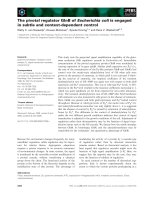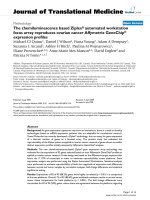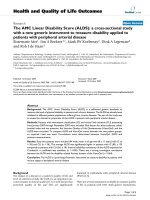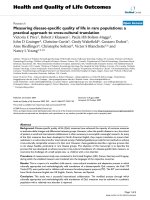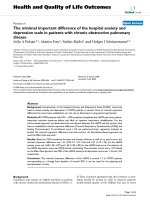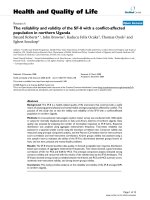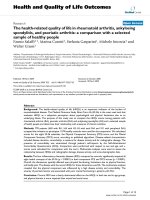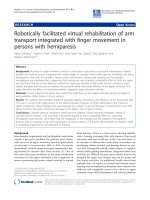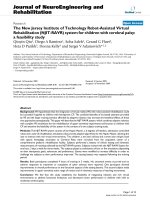Báo cáo hóa học: " The Linear Thermal Expansion of Bulk Nanocrystalline Ingot Iron from Liquid Nitrogen to 300 K" pot
Bạn đang xem bản rút gọn của tài liệu. Xem và tải ngay bản đầy đủ của tài liệu tại đây (322.43 KB, 7 trang )
NANO EXPRESS
The Linear Thermal Expansion of Bulk Nanocrystalline Ingot
Iron from Liquid Nitrogen to 300 K
S. G. Wang Æ Y. Mei Æ K. Long Æ Z. D. Zhang
Received: 7 August 2009 / Accepted: 9 September 2009 / Published online: 17 September 2009
Ó to the authors 2009
Abstract The linear thermal expansions (LTE) of bulk
nanocrystalline ingot iron (BNII) at six directions on roll-
ing plane and conventional polycrystalline ingot iron
(CPII) at one direction were measured from liquid nitrogen
temperature to 300 K. Although the volume fraction of
grain boundary and residual strain of BNII are larger than
those of CPII, LTE of BNII at the six measurement
directions were less than those of CPII. This phenomenon
could be explained with Morse potential function and the
crystalline structure of metals. Our LTE results ruled out
that the grain boundary and residual strain of BNII did
much contribution to its thermal expansion. The higher
interaction potential energy of atoms, the less partial
derivative of interaction potential energy with respect to
temperature T and the porosity free at the grain boundary of
BNII resulted in less LTE in comparison with CPII from
liquid nitrogen temperature to 300 K. The higher LTE of
many bulk nanocrystalline materials resulted from the
porosity at their grain boundaries. However, many authors
attributed the higher LTE of many nanocrystalline metal
materials to their higher volume fraction of grain
boundaries.
Keywords Linear thermal expansion Á
Bulk nanocrystallined materials Á Severe rolling technique
Introduction
The thermal properties of materials are important param-
eters for material applications and they are associated with
other physical and chemical properties. Thermal expansion
of materials are very complicated processes, which comes
from more than one contribution, such as electronic con-
tribution, magnetism, and lattice contribution, etc. There
can be no thermal expansion for harmonic approximation,
the atoms vibrate about their equilibrium positions sym-
metrically whatever be the amplitude. To account for
thermal expansion, one has to take into account the
anharmonicity of lattice vibration and quasi-harmonic
approximation, which provides the convenient method for
discussing the thermal expansion of materials at moderate
temperature [1]. The detailed theoretical discussion of
thermal expansion on this basis was given by Barron [2]. In
order to obtain thermal expansion of materials, one mea-
sured the temperature dependence of lattice parameter by
X-ray diffraction or neutron powder diffraction [3, 4]. The
negative thermal expansion of materials is an interesting
subject which has been extensively investigated, many
factors can cause negative thermal of materials, such as
discontinuous and anisotropic thermal lattice vibrations [5,
6], the phase transition [7], the materials structures which
can be characterized with rigid unit modes involving the
local vibrational motion [8], the anisotropic thermal
expansion to the saddle point van Hove singularity near the
Fermi level [9].
Nanocrystalline (NC) materials have attracted consid-
erable interests for their unusual physical, chemical, and
mechanical properties. The thermal expansion of many NC
materials has been investigated. The linear thermal
expansion (LTE) of NC copper was nearly twice larger
than that of its conventional coarse-grained polycrystalline
S. G. Wang (&) Á K. Long Á Z. D. Zhang
Shenyang National Laboratory for Materials Science, Institute of
Metal Research, and International Centre for Materials Physics,
Chinese Academy of Sciences, Shenyang 110016,
People’s Republic of China
e-mail:
Y. Mei
Institute of Sciences, Dalian Fisheries University,
Dalian 116023, People’s Republic of China
123
Nanoscale Res Lett (2010) 5:48–54
DOI 10.1007/s11671-009-9441-4
counterparts [10]. LTE of NC Ni–P alloy and the volume
expansion of NC Se synthesised by crystallization of
amorphous were 51 and 61% higher than those of their
conventional coarse-grained polycrystalline counterparts,
respectively [11, 12]. The thermal expansion of NC tita-
nium powder compacts prepared by high-energy attrition
milling was about 36% higher than that of titanium powder
compacts [13]. NC Cr [14], Pb [15], and Au [16] of Debye–
Waller parameters increased with decreasing grain size due
to the increased concentration of defects in grain boundary
with decreasing grain size. The increment of Debye–Waller
parameters for these NC materials means that the thermal
expansion of these NC materials increases with deceasing
grain sizes. The thermal expansion of NC Cu prepared by
magnetron sputtering increased with the increment of
residual strain, which may be attributed to the density
change of grain boundary defects/dislocations [17].
From above work on thermal expansion of NC materi-
als, they own enhanced thermal expansion in comparison
with their conventional polycrystalline counterparts. Many
authors attributed the higher thermal expansion of NC
materials to their metastable structure with the higher
volume fraction of grain boundaries and higher concen-
tration of defects/dislocations at grain boundaries [11–17].
However, in this work, we investigated LTE of bulk
nanocrystalline ingot iron (BNII) at six directions on roll-
ing surface and conventional polycrystalline ingot iron
(CPII) at one direction, our LTE results of BNII are dif-
ferent from enhanced LTE of other NC materials. We
explained qualitatively our LTE results with Morse
potential function and microstructure of polycrystalline
metals.
Experimental
Bulk nanocrystalline ingot iron was prepared by rolling
CPII. The details of severe rolling technique were described
in our previous report [18]. The microstructures of BNII
were characterized with a Philips CM200 transmission
electron microscope operated at 200 kV and X-ray dif-
fraction (XRD). The microstructure of CPII was examined
with XRD and optical microscopy. The measurement of
LTE of BNII and CPII was carried out by strain gage
method (Measurement of Thermal Expansion Coefficient
Using Strain Gages, Technical note, TN-513-1, pp 119–129
(2007), Vishay Intertechnology, Inc., Malvern, PA (USA),
www.vishaymg.com). All samples of BNII and CPII for
LTE measurement were 12 mm 9 9mm9 1 mm. LTE of
BNII were measured at six directions with different angles
at 0° (rolling direction), 30°,45°,60°,75°, and 90° (vertical
to rolling direction) against rolling direction on rolling
surface, the detailed description of LTE measurement
directions for BNII is shown in Fig. 1. LTE of CPII was
measured only in one direction due to the isotropy of CPII
microstructure. We measured the linear thermal expansion
parameter b
l
(T), it was defined as
b
l
ðTÞ¼
LðTÞÀLð300Þ
Lð300Þ
ð1Þ
L(T) and L(300) are the lengths of specimen at certain
measurement direction at temperatures T and 300 K,
respectively. Another thermal expansion parameter, the
linear thermal expansion coefficient g
l
(T), was defined as
g
l
ðTÞ¼
1
LðTÞ
dLðTÞ
dT
ð2Þ
We characterized the linear thermal expansion of BNII
and CPII with Eq. 1 rather than Eq. 2, because Eq. 1 can
directly characterize thermal expansion or contraction of
materials during temperature change. g
l
(T) may cause
unexpected error for measured data. For the same material,
b
l
(T)of Eq. 1 in one case was larger than that in another
case, while g
l
(T)of Eq. 2 in the former case may be less
than that of the latter case [19]. We fitted LTE data of BNII
and CPII with the following equation
b
l
TðÞ¼A
0
þ BT þ CT
2
þ DT
3
ð3Þ
at the temperature above H
D
/20. H
D
is Debye temperature
[1], and H
D
of iron is about 470 K [20]. H
D
/20 is about
23.5 K for iron. Therefore, Eq. 1 is suitable for fitting our
LTE results of BNII and CPII from liquid nitrogen tem-
perature (77 K) to 300 K [1].
Fig. 1 The schematic description of LTE measurement direction for
bulk nanocrystalline ingot iron
Nanoscale Res Lett (2010) 5:48–54 49
123
Results and Discussion
The transmission electron microscope image of BNII was
shown in our pervious work, the grain size of BNII varied
from 50 to 89 nm with an equiaxed structure [18]. Figure 2
presents LTE of BNII at six measurement directions on
rolling plane and CPII at one measurement direction from
liquid nitrogen to 300 K. From Fig. 2, LTE of BNII at six
measurement directions was less than that of CPII. For
BNII, LTE at 30° was least LTE among LTE at the six
measurement directions. Figure 2 indicates that BNII
behaves the better stability of linear thermal expansion in
comparison with CPII. Our LTE results of BNII are dif-
ferent from enhanced thermal expansion of other NC
materials, although BNII also has the higher grain bound-
ary volume fraction and higher concentration of defects at
grain boundary. However, many authors thought that the
two factors resulted in the enhanced thermal expansion for
NC materials and that LTE of NC materials increased with
decreasing grain sizes.
The measurement direction dependence of the parame-
ters A
0
, B, C, and D of BNII and CPII are shown in Figs. 3,
4, and 5, can be obtained by fitting the data of LTE of BNII
and CPII with Eq. 3. A
0
, C, and D of BNII and CPII are
negative values and B of BNII and CPII are positive values.
Therefore, we can think that T
2
term is associated with the
power of thermal expansion for BNII and CPII, which
origins from the energy that crystal lattice and conduction
electrons absorb with the increment of temperature [1]. T
and T
3
terms are associated with the resistance of thermal
expansion including the attractive forces among atoms, the
collision of conduction electrons, the texture, and defects
structure of materials, etc. According to Figs. 4 and 5, the
contribution of T term to thermal expansion is larger than
that of T
3
term for BNII and CPII. The absolute value of A
0
of CPII is less than those of BNII at the six measurement
directions in line with Fig. 3, which means that the
shrinkages of BNII at six measurement directions were
larger than that of CPII when temperature T ? 0. B of
CPII is less than that of BNII at 90°, and is larger than
those of BNII at the rest five measurement directions. C of
CPII is less than those of BNII at all the measurement
directions, which means that the power of thermal expan-
sion was enhanced for BNII. D of CPII is less than that of
BNII at 60°, and is larger than those of BNII at the rest five
measurement directions. The attractive forces among atoms
should contribute to thermal expansion as T term because
B(*10
-6
) is larger than D(*10
-11
). We should need other
further investigation and experiments if we intend to
understand the effect of above each factor on thermal
expansion as T or T
3
term. This is an interesting and fun-
damental problem for thermal expansion. We will inves-
tigate this problem further in the future. We also should
Fig. 2 The linear thermal expansion b(T) of BNII and CPII from
liquid nitrogen temperature to 300 K
Fig. 3 The measurement direction dependence of the parameter A
0
of
BNII and CPII
Fig. 4 The measurement direction dependence of the parameter B
and D of BNII and CPII
50 Nanoscale Res Lett (2010) 5:48–54
123
consider the magnetic contribution to thermal expansion
for magnetic materials. Although the power of thermal
expansion of BNII was enhanced in comparison with that
of CPII in line with Fig. 4, the resistance of thermal
expansion for BNII were also larger than that of CPII from
Figs. 4 and 5 in the meantime. As the result of the com-
petition between the power and resistance of thermal
expansion, the actual thermal expansion of BNII was less
than that of CPII from Fig. 2, which means that the power
of thermal expansion is less than the resistance of thermal
expansion for BNII. The power and resistance of thermal
expansion depend on the variation of interaction potential
energy among atoms with temperature.
In the view of physics nature, the thermal expansion of
condensed materials was formed after the atoms absorbed
energy and the distances between them became larger with
temperature. The motion of atoms was determined by their
interaction potential energy and their variation with tem-
perature T. The larger interaction potential energy among
atoms and the less its variation with temperature T, the
more difficult the thermal expansion is. The interaction
potential energy between the two atoms i and j for bulk
materials could be characterized by Morse potential func-
tion /
j
(i, T) at temperature T [21]
/
j
ði; TÞ¼Ae
À2a r
i;j
TðÞÀr
0
½
À e
Àa r
i;j
TðÞÀr
0
½
no
ð4Þ
where a and A are the constants with dimensions of
reciprocal distance and energy, respectively, and r
0
is the
equilibrium distance of approach of the two atoms, the
three parameters depend on materials and their processes
history, etc. r
i,j
(T) is the distance between two atoms i and j
at temperature T. We usually consider the interaction
potential energy between the nearest neighbor atoms for
metal materials. In fact, we should also consider the effect
of the second neighbor atoms on interaction potential
energy [22]. /
NANO
i; TðÞand /
CPII
ði; TÞ stand for the total
interaction potential energies of atom i among its the
nearest and second neighbor atoms of BNII and CPII at
temperature T, respectively. /
m
NANO
ði; TÞ and /
m
CPII
ði; TÞ are
the interaction potential energies between atom i and the
nearest neighbor atom m for BNII and CPII, respectively.
/
n
NANO
ði; TÞ and /
n
CPII
ði; TÞ are the interaction potential
energies between atom i and the second neighbor atom n
for BNII and CPII, respectively. m and n are 8 and 6 for
metals with body-centered-cubic structure, respectively; m
and n are 12 and 6 for metals with face-centered-cubic
structure, respectively. We can obtain the following
equation
/
NANO
ði; TÞ[ /
CPII
ði; TÞð5Þ
because BNII suffered from severe rolling and severe
deformation processes can enhance the interaction
potential energy among atoms, residual strain, and
concentration of defects at grain boundary. It is well-
known that the interaction potential energy among atoms
should decrease with the increment of temperature, and
then the interaction distance of atoms increased with
temperature, so thermal expansion happened. We defined
f
NANO
i; TðÞand f
CPII
i; TðÞas the first partial derivative of
/
NANO
ði; TÞ and /
CPII
ði; TÞ with respect to temperature T
for BNII and CPII, respectively
f
NANO
i; TðÞ¼
o/
NANO
ði; TÞ
oT
ð6Þ
f
CPII
i; TðÞ¼
o/
CPII
ði; TÞ
oT
ð7Þ
In fact, linear thermal expansion depends on interaction
potential energy, the first partial derivative of interaction
potential energy with respect to temperature T and c, the
linear density of atoms at certain measurement direction. c
depends on crystal structure of metals (such as face-
centered-cubic and body-centered-cubic structure, etc.) and
the measurement direction. The larger /(i, T) and the less
f(i, T), the less thermal expansion is; the larger the linear
density of atoms, the larger linear thermal expansion is.
Therefore, we can give the following Eq. 8 from Fig. 2
f
NANO
i; TðÞ f
CPII
i; TðÞ ð8Þ
The values of f
NANO
i; TðÞand f
CPII
i; TðÞdepend on the
three parameters B, C, and D of BNII and CPII. According
to the physical nature of linear thermal expansion and
above discussion, we can obtain the following equation
b
l
ðTÞ/ fði; TÞ
jj
½
t
c ð9Þ
where t is a constant. We can explain qualitatively the
results of LTE for BNII and CPII: (1) LTE of BNII at six
Fig. 5 The measurement direction dependence of the parameter C of
BNII and CPII
Nanoscale Res Lett (2010) 5:48–54 51
123
measurement directions were less than those of CPII
because /
NANO
ði; TÞ was larger than /
CPII
ði; TÞ and
f
NANO
i; TðÞwas less than f
CPII
i; TðÞ; (2) LET of BNII
depend on measurement direction because c depends on
crystal structure and measurement direction. The rolling
surface was combined with several crystalline planes from
X-ray diffraction of BNII and CPII at room temperature as
shown as Fig. 6 [18], the atoms at certain measurement
direction come from different crystalline planes, c is dif-
ficult to be calculated for polycrystalline metals. It is also
difficult to determine the interaction potential energy
among atoms and its variation with temperature, they are
associated with many factors, such as kinds of atoms, the
microstructure of materials, heat treatment history, and
rolling history, etc. Therefore, it is difficult to analyze
quantitatively linear thermal expansion and there is a
paucity of theoretical work on the thermal expansion of
anisotropic materials. A lot of theoretical problem on
thermal expansion should be investigated further in the
future.
LTE of polycrystalline metal materials can be described
by two-component system, the crystallite component and
grain boundary component [23]. It is well-known that the
thermal expansion of coarse-grained polycrystalline mate-
rials comes from crystallite and grain boundary, and that
grain boundary has less contribution to the thermal
expansion because of their very little fraction volume in the
view of materials science. Many authors thought that LTE
of many bulk NC materials were higher those of their
conventional coarse polycrystalline counterparts due to the
higher volume fraction of NC materials grain boundaries
and concentration of defects at grain boundaries [10–17]. It
is normally considered that the thermal expansion of grain
boundary was enhanced in comparison with that of crys-
tallite due to their excess volume for bulk NC materials
[15, 23]. However, the grain boundary of BNII did less
contribution to thermal expansion because LTE of BNII at
six measurement directions were less than those of CPII
from liquid nitrogen to 300 K according to Fig. 2. It was
suggested that the relatively large changes of the thermal
expansion previously reported may be due to porosity
rather than the small grain size [23]. The thermal expansion
of porosity is larger than that of atom in crystallite and
grain boundary during the increment of temperature, which
can cause enhanced thermal expansion for many bulk NC
materials. The pressure of porosity increases with the
decrement of grain sizes and increment of temperature. The
grain boundary of BNII can not exist porosity because
BNII maintained bulk state all the time during severe
rolling process, it is impossible that porosity could be
introduced during severe rolling processes, and the grain
boundary of BNII can not be polluted by porosity or other
atoms.
LTE of polycrystalline materials can be described by
two-component system as following equation [24]
a
l
¼ F
GBs
a
GBs
l
þð1 À F
GBs
Þa
c
l
ð10Þ
where, a
l
, a
l
GBs
, and a
l
c
are LTE of bulk, grain boundary,
and crystalline, respectively. F
GBs
is the volume fraction of
grain boundary,
F
GBs
¼
3d
d
ð11Þ
where d and d are constants relative to the grain boundary
thickness and grain size, respectively. The ratios of a
GBs
l
=a
c
l
were between 1.2 and 12.7 for NC Ni–P alloy with dif-
ferent grain sizes [11], and 2.5–5.0 for other NC materials
[15, 25]. According to Fig. 2, the thermal expansion of
BNII mainly come from the contribution of crystallite
because LTE of BNII are less than those of CPII. From
Fig. 2, the crystal lattice parameters of BNII grew at slower
velocity in comparison with those of CPII from liquid
nitrogen to 300 K. One can obtain volume expansion of
materials with the data of lattice parameters at different
temperature. However, linear thermal expansion of mate-
rials cannot be obtained with the data of lattice parameters
except for single crystal materials because grain orienta-
tions of polycrystalline materials are very difficult to
determine along the measurement direction [17]. We had to
conclude that grain boundary of BNII do less contribution
to its thermal expansion. Our LTE results of BNII and CPII
were very different from enhanced thermal expansion for
other NC materials compared to their conventional poly-
crystalline counterparts [10–16] and negative thermal
expansion of materials [5–9]. However, as shown as Fig. 2,
b
l
(T) of BNII are less than those of CPII, although BNII
has higher volume fraction of grain boundary and residual
strain as shown our previous work [18]. The better stability
of linear thermal expansion of BNII, the higher tensile
Fig. 6 The X-ray diffraction of BNII and CPII at room temperature
52 Nanoscale Res Lett (2010) 5:48–54
123
strength [26], enhanced wear and corrosion resistance of
BNII, and enhanced corrosion resistance of bulk nano-
crystalline stainless steel 304 [18, 27–29] in comparison
with those of their conventional polycrystalline counter-
parts. Therefore, BNII and bulk nanocrystalline 304
stainless steel prepared by severe rolling technique are
potential to be applied in many fields. Severe rolling
technique for bulk nanocrystalline metal materials can
improve several properties in comparison with their con-
ventional coarse polycrystalline counterparts at the same
time rather than improve certain property at cost of another
property. This is the advantage and feature different from
other preparation techniques for bulk nanocrystalline metal
materials.
Residual strain exists in BNII because BNII was suf-
fered from severe rolling during preparation processes [18].
However, LTE of BNII at six measurement directions were
less than those of CPII from liquid nitrogen temperature to
300 K, which indicates that the residual strain of BNII did
not contribute to the LTE of BNII. In fact, the residual
strain can increase interaction potential energy among
atoms, and then they were eliminated gradually with tem-
perature. Therefore, residual strain can make thermal
expansion slow down. In fact, residual strain can increase
the pressure of porosity at grain boundary, which can result
in the higher LTE of many NC materials in comparison
with their conventional polycrystalline counterparts
because porosity at grain boundary usually expanded more
quickly compared to metal atoms at crystallite and crys-
talline boundary. So it is easy to understand the fact that the
thermal expansion of some NC materials increased with
residual strain, and that the reason why LTE of many other
bulk NC materials were higher than their conventional
coarse polycrystalline counterparts, and that many authors
attributed the higher thermal expansion of NC materials to
their higher volume fraction of grain boundary and residual
strain [11, 13, 17, 30].
It was suggested that the relatively large changes of
thermal expansion previously reported may be due to
porosity or impurity at grain boundary rather than the small
grain size [31]. Our experimental results in linear thermal
expansion support this point of view. It is normally con-
sidered that the grain boundary have an enhanced thermal
expansion in comparison with that of crystallite due to their
excess volume [21]. Many preparation techniques, such as
inert gas condensation, ball-milling, and magnetron-sput-
tering, changed the state of materials, such as bulk ?
powder ? bulk or thin film and powder ? bulk during
nanocrystallization processes. Many NC materials have a
considerable amount of entrained porosity, which was
introduced during nanocrystallization processes. The
porosity in NC materials may drastically alter results for
the thermal expansion and, therefore, impair measurement
reliability and accuracy. In fact, the thermal expansions of
NC materials were found to be sensitive to the mode of
preparation and their consequent time–temperature history
[17, 30–32]. However, the densities, state and compositions
of NC materials by severe rolling technique were not
changed and their microstructures of grain boundary were
continuously changed with porosity free at grain boundary
during the whole preparation processes. This is the reason
why the grain boundary did less contribution to the thermal
expansion of BNII.
Conclusion
Bulk nanocrystalline ingot iron had less linear thermal
expansion in comparison with conventional polycrystalline
ingot iron from liquid nitrogen temperature to 300 K. The
thermal expansion depends on the interaction potential
energy of atoms and the first partial derivative of it with
respect to temperature, grain boundary structure, and
residual strain, etc. Different preparation techniques of
bulk nanocrystalline metal materials can result in different
microstructures associated with thermal expansion. We can
rule out the larger contribution of grain boundary and
residual strain to linear thermal expansion for BNII. The
porosity free at BNII grain boundary results in the less
contribution of higher volume fraction and residual strain
to thermal expansion of BNII. Linear thermal expansion of
many NC materials was higher than those of their con-
ventional coarse polycrystalline counterparts because the
expansion velocity of the porosity at the grain boundary is
larger than the expansion velocity of atoms inside crys-
tallite and at grain boundary.
Acknowledgments Authors are grateful to the financial support of
Natural Sciences of Foundation of China, Contract No.: 50501023,
50771098 and the National Major Fundamental Research Program
(No. 2010CB934603) of China, Ministry of Science and Technology
China.
References
1. R.S. Krishnan, R. Srinivasan, S. Devanarayanan, Thermal
Expansion of Crystals (Pergamon Press, Oxford, 1979)
2. T.H.K. Barron, Philos. Mag. 46, 720 (1955)
3. Y. Yamamura, N. Nakajima, T. Tsuji, Phys. Rev. B 64, 184109
(2001)
4. R.J. Bruls, H.T. Hintzena, R. Metselaara, C.K. Loong, J. Phys.
Chem. Solids 61, 1285 (2000)
5. K. Takenaka, H. Takagi, Appl. Phys. Lett. 87, 261902 (2005)
6. T.A. Mary, J.S.O. Evans, T. Vogt, A.W. Sleight, Science 272,90
(1996)
7. C. Lind, A.P. Wilkinson, Z. Hu, S. Short, J.D. Jorgensen, Chem.
Mater. 10, 2335 (1998)
8. A.L. Goodwin, C.J. Kepert, Phys. Rev. B 71, 140301 (2005)
Nanoscale Res Lett (2010) 5:48–54 53
123
9. P. Souvatzis, O. Eriksson, M.I. Katsnelson, Phys. Rev. Lett. 99,
015901 (2007)
10. R. Birringer, Mater. Sci. Eng. A 117, 33 (1989)
11. M.L. Sui, K. Lu, Nanostruct. Mater. 6, 651 (1995)
12. Y.H. Zhao, K. Zhang, K. Lu, Phys. Rev. B 56, 14322 (1997)
13. B.B. Panigrahi, M.M. Godkhindi, J. Mater. Res. 20, 580 (2005)
14. J.A. Eastman, M.R. Fitzsimmons, J. Appl. Phys. 77, 522 (1994)
15. J.A. Eastman, M.R. Fitzsimmons, L.J. Thompson, Philos. Mag. B
66, 667 (1992)
16. K. Ohshimak, A. Hayashi, J. Harada, J. Phys. Soc. Jpn. 48, 1631
(1980)
17. L.H. Qian, S.C. Wang, Y.H. Zhao, K. Lu, Acta Mater. 50, 3425
(2002)
18. S.G. Wang, C.B. Shen, K. Long, H.Y. Yang, F.H. Wang, Z.D.
Zhang, J. Phys. Chem. B 109, 2499 (2005)
19. P. Qin, Y. Chen, J. He, W. He, L. Nong, L. Zeng, Mater. Chem.
Phys. 109, 515 (2008)
20. C. Kittel, Introduction to Solid State Physics, 7th edn. (Wiley,
New York, 1996), p. 126
21. L.A. Girifalco, V.G. Weizer, Phys. Rev. 114, 687 (1959)
22. S.G. Wang, E.K. Tian, C.W. Lung, J. Phys. Chem. Solids 61,
1295 (2000)
23. H.J. Klam, H. Hahn, H. Gleiter, Acta Mater. 35, 1987 (2101)
24. Y.H. Zhao, H.W. Sheng, K. Lu, Acta Mater. 49, 365 (2001)
25. R. Birringer, H. Gleiter, in Advance in Materials Science.
Encyclopedia of Materials Science and Engineering, ed. by R.W.
Cahn (Pergamon Press, Oxford, 1988), p. 339
26. S.G. Wang, K. Long, C.W. Lung, Acta Metall. Sin. 39, 1247
(2003)
27. S.G. Wang, C.B. Shen, K. Long, T. Zhang, F.H. Wang, Z.D.
Zhang, J. Phys. Chem. B 110, 377 (2006)
28. X.R. Lv, S.G. Wang, Y. Liu, K. Long, S. Li, Z.D. Zhang, Wear
264, 535 (2008)
29. N. Li, Y. Li, S.G. Wang, F.H. Wang, Electrochim. Acta 52, 760
(2006)
30. H. Zhang, B.S. Mitchell, Mater. Sci. Eng. A 270, 237 (1999)
31. T. Turi, U. Erb, Mater. Sci. Eng. A 204, 34 (1995)
32. H. Gleiter, Nanostruct. Mater. 6, 3 (1995)
54 Nanoscale Res Lett (2010) 5:48–54
123

